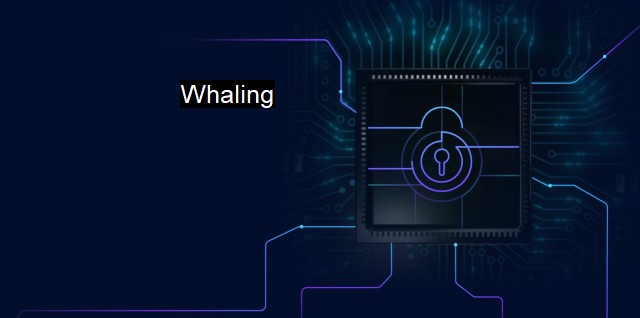What is Whaling?
Whaling: The Targeted Cyber Attack Impersonating C-Level Executives for Business Email Compromise (BEC)
Whaling, with is a specific type of cyber-attack. Different from phishing attacks that involve random users, whaling attacks are effectively spear-phishing attacks but directed towards high-ranking targets such as CEOs, CFOs, and other executives. These targets are known as "big fish," hence the term "whaling" is used to describe these attacks.One may wonder, why target these high-profile individuals? The answer lies in the vast wealth of valuable and sensitive information that is held by these targets, ranging from financial data, confidential company data, or access credentials to critical infrastructures. In some cases, when the attack is successful, the hackers can carry out financial fraud or steal business secrets for competitive advantages.
Just like various phishing attacks, whaling attacks primarily rely on social engineering techniques to trick the victim. as opposed to simply posing as a trustworthy entity like in spear-phishing, a whaling email is purposely crafted to target the specific individual with an urge of immediate action for a plausible situation. Perfection in crafting deceptive emails involves thorough research about the individual’s social and professional activities, work details, personal interests, and any other potential vulnerability they can exploit.
Whaling emails tend to be more sophisticated than common phishing emails, often disguised as something critical, like a legal subpoena, customer complaint, or a high-priority business transaction, making them look more trustworthy and convincing. They not only need to bypass the company’s antivirus or spam software, but also present a compelling case that trick victims into completing the requested action, which often involves divulging sensitive information, downloading malicious software, or approving substantial financial transactions.
Another huge concern with whaling attacks is the increase in the use of advanced methods such as Business Email Compromise (BEC) which has resulted in substantial financial losses worldwide. In a BEC attack, the attacker impersonates a high-profile executive, usually the CEO, to trick the finance department or any other target into transferring large funds into an account controlled by the attacker.
On another note, hackers implementing whaling attacks quickly adapt to the advanced antivirus solutions coming up each day. They employ ruses such as using malicious macros or infected PowerShell scripts hidden in the common non-executable file types that are not typically scanned rigorously by antivirus software. This shows a level of sophistication that makes these attacks more challenging to detect and prevent.
How can companies guard themselves against whaling? Like with many other cybersecurity threats, an ounce of prevention is worth a pound of cure. Training and awareness about whaling attacks among high-ranking officials are a must. Recognizing the signs of fraud and knowing the right points of action when there’s doubt are valuable investments.
a robust, comprehensive cybersecurity strategy is essential. Phishing detection, two-factor authentication, and secure email gateways can help prevent these attacks. Regular update of antivirus software to protect against malware further implies the importance of a multi-layered security approach.
Unfortunately, the fight against whaling, or any cyber-attack, isn’t straightforward due to the continuous evolution and creativity of malicious hackers. with a combination of awareness, vigilance, defense in-depth strategy, and appropriate technologies, it is possible to keep companies not just a step ahead, but proactive, without waiting for an attack to respond to.
"whaling" is a sharp reminder of how cyber threats are not just becoming increasingly intricate but also rising up the ranks, targeting top executives. As such, it constitutes a cybersecurity challenge that, while demanding sophisticated techniques for prevention, plays a significant role in shaping the role of cybersecurity in an organization to tackle ever-evolving cyber threats.

Whaling FAQs
What is whaling in cybersecurity?
Whaling, also known as CEO fraud, is a type of targeted phishing attack that focuses on high-level executives or individuals with access to sensitive information. The attackers impersonate a trusted contact or authority figure to gain access to sensitive data or convince the victim to transfer funds.What are some indicators of a whaling attack?
Some indicators of a whaling attack include urgent requests for large money transfers, requests for confidential data or employee W2 forms, and emails that appear to come from a higher authority but have a suspicious domain name or email address.How can I protect myself and my organization from whaling attacks?
To protect yourself from whaling attacks, educate employees on how to spot phishing attempts and encourage them to verify requests for sensitive information in person or through a secondary communication channel. Implementing two-factor authentication and email filters can also help prevent unauthorized access to sensitive data.What should I do if I suspect my organization has fallen victim to a whaling attack?
If you suspect your organization has fallen victim to a whaling attack, immediately contact your IT and security teams and instruct employees not to respond to any suspicious or urgent requests until the situation has been resolved. It is also recommended to report the attack to law enforcement and consider hiring a cybersecurity firm to investigate the breach and provide remediation recommendations.| | A | | | B | | | C | | | D | | | E | | | F | | | G | | | H | | | I | | | J | | | K | | | L | | | M | |
| | N | | | O | | | P | | | Q | | | R | | | S | | | T | | | U | | | V | | | W | | | X | | | Y | | | Z | |
| | 1 | | | 2 | | | 3 | | | 4 | | | 7 | | | 8 | | |||||||